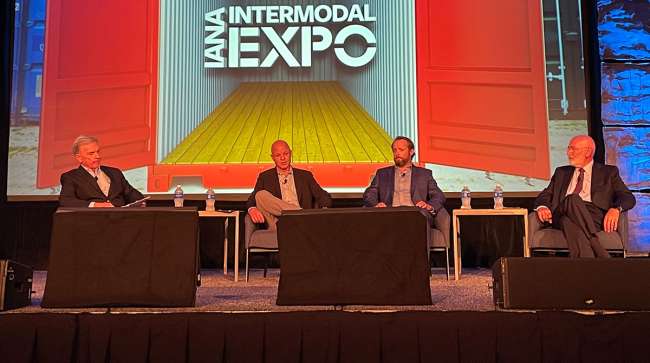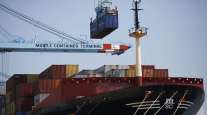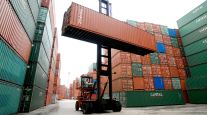Contributing Writer
IANA 2021: Massive Imbalances Plague Intermodal Industry

[Stay on top of transportation news: Get TTNews in your inbox.]
LONG BEACH, Calif. — Global trade patterns distorted by the COVID-19 pandemic have thrown the intermodal shipping industry out of whack, creating massive imbalances in shipping containers, intermodal chassis and drayage drivers.
That’s the assessment of an expert panel during the Intermodal Association of North America’s Intermodal Expo on Sept. 13.
“The intermodal industry is under unprecedented strain,” said Larry Gross, founder and president of Gross Transportation Consulting. “A host of problems have ricocheted across the entire industry.”

Gross
Virtually every segment, from shipping to rail to trucking, struggles to get capacity in the best locations and find enough drivers and staff to keep operations running smoothly, he said.
“Part of the challenge that we face is the lopsided nature of development in the wake of COVID,” Vespucci Maritime CEO Lars Jensen said.
Speaking by teleconference from Copenhagen, Denmark, Jensen said other nations aren’t matching the explosion in import volume to the U.S. Globally, trade volumes are only slightly above their pre-pandemic levels. That has caused shipping lines to relocate vessels to the Pacific shipping lanes and create a global imbalance.
“You could offload a gigantic amount of containers into the terminals, but what happens is that the importers do not pick up those containers as fast as they used to,” Jensen said. “This creates a lopsided mess in transport.”
Moreover, Jensen said that there are at least 50 containerships sitting idle outside of the massive Port of Los Angeles and Port of Long Beach complex, waiting to be unloaded. That represents about 400,000 TEUs (20-foot equivalent units) floating outside the port.

Lars Jensen (Vespucci Maritime)
“That leads to a distinct shortage of capacity, something we’ve never seen in the history of container shipping,” Jensen said.
Problems and imbalances only continue once containers are offloaded, the panelists said.
Drayage drivers, frustrated by poor equipment and long delays at ports, are taking other driving jobs or leaving the industry.
There also is a critical shortage of the chassis truckers use to transport containers.
Tim Denoyer, vice president and senior analyst for ACT Research, said much of the shortage results from import duties estimated at more than 200% that the U.S. placed on chassis from China, the main producer. That has slashed purchases as the new tariffs add more than $25,000 to the price of each imported chassis, tripling the price, according to the Cato Institute. And U.S. manufacturers don’t have enough capacity to fill the gap quickly.
Check out what is happening in the freight market from ACT Research Co., LLC's Tim Denoyer and Cass Information Systems #TransportationIndexReport.#freight #transportation #logistics #supplychain #shipper #ACT #ACTResearchhttps://t.co/snnrq3Nxgh pic.twitter.com/s5KrOH7bCv — ACT Research (@actresearch) September 13, 2021
Meanwhile, the aging chassis fleet in the U.S. is breaking down at a time when demand has soared, making the problem worse.
“I don’t think this is something we can solve quickly,” Denoyer said. It may take the better part of a year to sort out, and in the meantime, the intermodal industry is “going to have to do more with less.”
Most of the problems the industry is suffering from right now are not enough capacity to move goods through the global supply chain, Jensen said. But he doesn’t think one of the lessons the industry will learn from the pandemic is to keep a level of overcapacity in the system.
Companies gradually will build up now but will trim back over subsequent years to operate at peak efficiency, he said. Competition forces companies into that strategy.
“Over time, nothing will really change because one is willing to pay for substantial overcapacity only to have it sit idle for decades in the event that something like this happens again,” Jensen said.
But Gross disagrees.
“We now live in a period where black swan events such as the one we just went through seemed to be occurring with great frequency,” he said. “There’s always some unpredictable event that’s going to be occurring with much greater frequency than before. … We need to figure out ways to make the system a little bit more resilient.”

Fleet managers find that healthy, happy drivers are key to business success. Stephen Kane of Rolling Strong says driver health starts with “being vulnerable enough to listen to somebody that knows about health.” Hear a snippet above, and get the full program by going to RoadSigns.TTNews.com.
Technology advances could help accomplish that, Armstrong & Associates President Evan Armstrong said.
For example, Convoy uses digital tools and sensors that track loads to get better use out of trailers.
“They have a drop-and-hook program where they’re basically planning for those trailers all the time, getting the capacity of say 3,000 trailers out of just a thousand,” Armstrong said.
“Technology can definitely help maximize what we can do with the fixed capacity because, at the end of the day, there are only so many trucks, there’s only so much infrastructure environment,” he added.
Autonomous trucks are another area in which technology can relieve another bottleneck — the driver shortage, Denoyer said.
He believes that there could be tens of thousands of autonomous trucks plying major highways within two or three years.
“You’ll be able to put new fuel tags on these things and send the autonomous trucks all the way across the country very quickly,” he said.
Want more news? Listen to today's daily briefing below or go here for more info:




